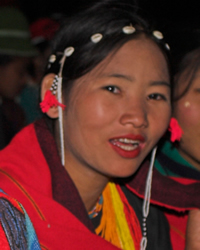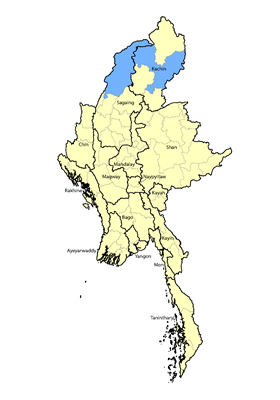Lakki in Myanmar (Burma)

Photo Source:
Asia Harvest-Operation Myanmar
|

Map Source:
Asia Harvest-Operation Myanmar
|
| People Name: | Lakki |
| Country: | Myanmar (Burma) |
| 10/40 Window: | Yes |
| Population: | 1,400 |
| World Population: | 1,400 |
| Primary Language: | Language unknown |
| Primary Religion: | Christianity |
| Christian Adherents: | 60.00 % |
| Evangelicals: | 30.00 % |
| Scripture: | Unspecified |
| Ministry Resources: | No |
| Jesus Film: | No |
| Audio Recordings: | No |
| People Cluster: | South Asia Tribal - Naga |
| Affinity Bloc: | South Asian Peoples |
| Progress Level: |
|
Identity
The Lakki are often thought to be the same as the Kuku tribe, but researchers confirm they have a different sense of identity and that the two groups, though culturally related, speak distinct dialects. A linguist noted one of the difficulties that causes groups like the Lakki to be overlooked by authorities and scholars alike: “Ethnic identities can be quite political. The larger the population, the more political power. Therefore, there is often pressure from politicians to combine ethnic identities (and even enforce use of languages that people don't understand). On the Myanmar side, many groups speaking Naga languages have been politically grouped as Tangshang. On both sides of the border, distinct languages are being subsumed under larger ethnic identities.”
Location: Numbering 1,400 people, the Lakki people inhabit areas in northern Myanmar’s Kachin State. They are concentrated near the small town of Shinbwiyan, which sits within Tanai Township. Tanai was formerly part of Myitkyina District until 2022, when the government declared it was now the only town in the newly formed Tanai District. Lakki families are distributed throughout over a dozen ethnically-mixed villages in the area, but 30 Lakki households are known to have settled down in Thayatit Village, and another ten families live in the village of Lakyabum and eight in Tarung. The Lakki are one of only six out of more than 50 Tangshang tribes in Myanmar that are primarily located outside the Sagaing Region. Only a small number of Lakki families still live in their previous homeland in the Sagaing Region’s Lahe Township.
Language: In 2013, linguists traveled to Kachin State and surveyed 475 Lakki people. They concluded that Lakki is most similar to four other Tangshang varieties (Gaqchan, Khalak, Lungkhi, and Shangti), and that church leaders from the five groups have expressed an interest in developing their own Lungkhi Bible translation team. All five tribes live in or near Shinbwiyan town in the Tanai District.
History
Shinbwiyan has become a popular place for various Tangshang groups, including the Lakki, to migrate to due to its relatively easy access and fertile land. Tanai is a much-sought-after location and a battleground of the Myanmar civil war between the Burmese military and the Kachin Independence Army because it encompasses gold mines and other valuable resources. Although the Lakki are located north of the epicenter, they were severely shaken by the massive 7.7 earthquake that struck the region on March 28, 2025.
Customs
Because the Lakki people have been hidden away from the world for centuries, little is known about their culture apart from fleeting mentions in some publications. One source said that “while headmen had the right to punish any individual who did not accede to his demands or requests for assistance, the Lakki allowed the headman to have two wives, while the rest of the village were only allowed one.”
Religion
When the Lakki people migrated to their current location in Kachin State, they came under the influence of the Burmese and other Buddhist groups. Certain government benefits are given to Buddhists that are not available to Christians or people of other faiths, and today approximately 40 percent of Lakki people are believed to have abandoned Christianity to become Buddhists.
Christianity
When the Lakki arrived in Kachin State they also came within the scope of Kachin Jingpo Christians who are known for their zealous evangelism. With the Christian faith under pressure from Buddhism, the Lakki need the Scriptures in their heart language, but despite some expressions of intent, it appears no translation project has been commenced to provide the Bible in a language that will strengthen the Lakki believers.